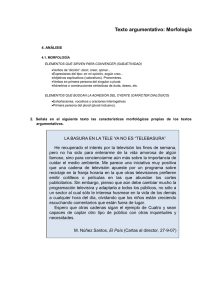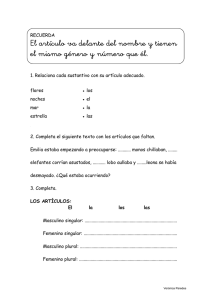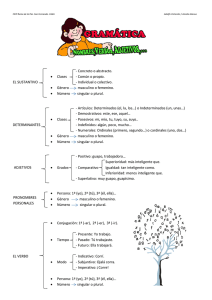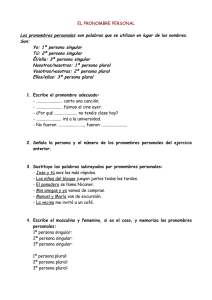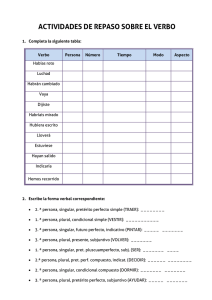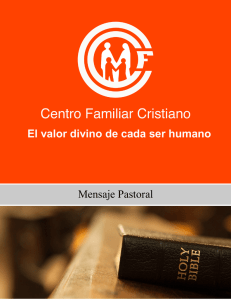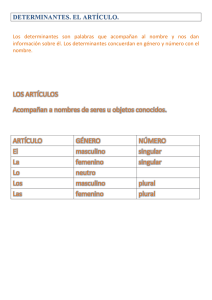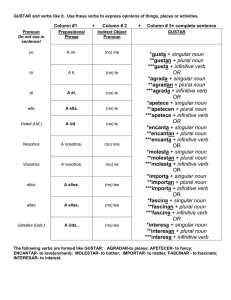Elementos gramaticales en español
Anuncio
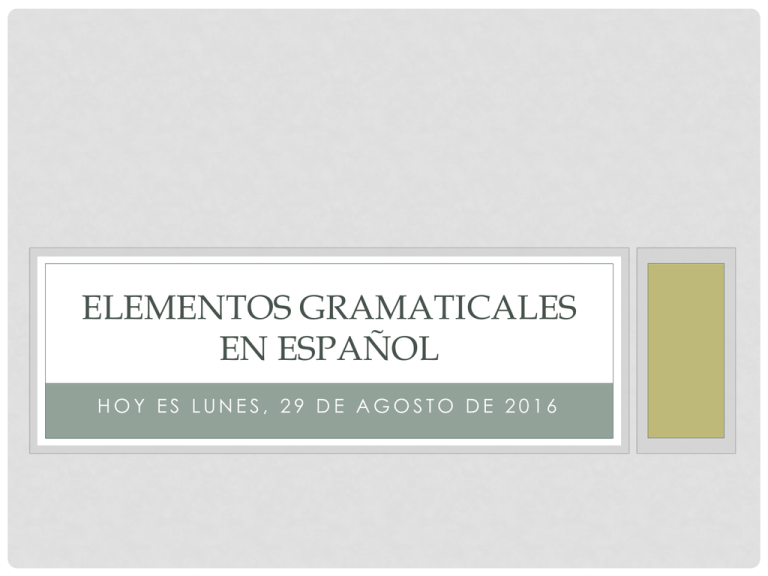
ELEMENTOS GRAMATICALES EN ESPAÑOL HOY ES LUNES, 29 DE AGOSTO DE 2016 CHAMPS • C – Level 0 Level 2 • H – Raise your hand • A – Direct Teaching • M – With permission only • P – Take notes and ask questions • S – Success! LECCIÓN DEL DÍA • Topic: • Spanish I review • Objective(s) AIM: • I will review and evaluate my Spanish I knowledge. • TEKS: • Comunication: 1.1, 1.2 • Connection: 3.1 • Schedule: • Champs/Lección del día • Presentation • Parts of Speech • Conjugations • QOD • Agenda (Plannner): LOS ARTÍCULOS – ARTICLES • is a word that is used with a noun to indicate the type of reference being made by the noun. • Artículos definidos: el, la, los, las • Artículos indefinidos: un, una, unos, unas EL SUSTANTIVO - NOUN • is a word that functions as the name of some specific thing or set of things, such as living creatures, objects, places, actions, qualities, states of existence, or ideas. • Artículos definidos y sustantivos: El hijo La maestra Los profesores Las bailarinas • Artículos indefinidos y sustantivos: Un hijo Una maestra Unos profesores Unas bailarinas LOS PRONOMBRES - PRONOUNS • is a word that substitutes for a noun or noun phrase. • Artículos definidos(indefinidos) y sustantivos > Pronombre I > Yo You > Tú (informal)/ Usted (formal) El (un)hijo > Él La (una) maestra > Ella/Usted Los (unos) profesores > Ellos/Ustedes Las (unas) bailarinas > Ellas TABLA DE PRONOMBRES Singular Plural 1ª Persona Yo Nosotros (as) 2ª Persona Tú Vosotros (as) 3ª Persona Él/Ella/Usted Ellos/Ellas/Ustedes • Remember: Formal vs. Informal LOS ADJETIVOS - ADJECTIVES • is a describing word, the main syntactic role of which is to qualify a noun or noun phrase, giving more information about the object signified. • Ejemplos: Sustantivo + adjetivo El sillón rojo La mesa roja Las sillas rojas El hijo inteligente La maestra inteligente Los estudiantes inteligentes LOS VERBOS • is a word that in syntax conveys an action (bring, read, walk, run, learn), an occurrence (happen, become), or a state of being (be, exist, stand). • Terminaciones de los verbos en español: -ar, -er, -ir • Verbs ending with –ar, –er, –ir are called “Infinitivos” hablar (to talk) comer (to eat) vivir (to live) LA CONJUGACIÓN - CONJUGATION • the variation of the form of a verb in an inflected language such as Latin, by which are identified the voice, mood, tense, number, and person. • Steps: 1. Use an infinitive (–ar, -er, -ir) 2. Take away the ending 3. Insert new appropriate ending. REGULAR VERBS IN THE PRESENT TENSE • Verbos con terminación –ar (regular): Singular Plural 1ª Persona -o -amos 2ª Persona -as -áis 3ª Persona -a -an REGULAR VERBS IN THE PRESENT TENSE • Verbos con terminación –ar (regular): hablar Singular Plural 1ª Persona hablo hablamos 2ª Persona hablas habláis 3ª Persona habla hablan REGULAR VERBS IN THE PRESENT TENSE • Verbos con terminación –er (regular): Singular Plural 1ª Persona -o -emos 2ª Persona -es -éis 3ª Persona -e -en REGULAR VERBS IN THE PRESENT TENSE • Verbos con terminación –er (regular): comer Singular Plural 1ª Persona como comemos 2ª Persona comes coméis 3ª Persona come comen REGULAR VERBS IN THE PRESENT TENSE • Verbos con terminación –ir (regular): Singular Plural 1ª Persona -o -imos 2ª Persona -es -ís 3ª Persona -e -en REGULAR VERBS IN THE PRESENT TENSE • Verbos con terminación –ir (regular): vivir Singular Plural 1ª Persona vivo vivimos 2ª Persona vives vivís 3ª Persona vive viven Q.O.D. How much did you remember from Spanish I?
